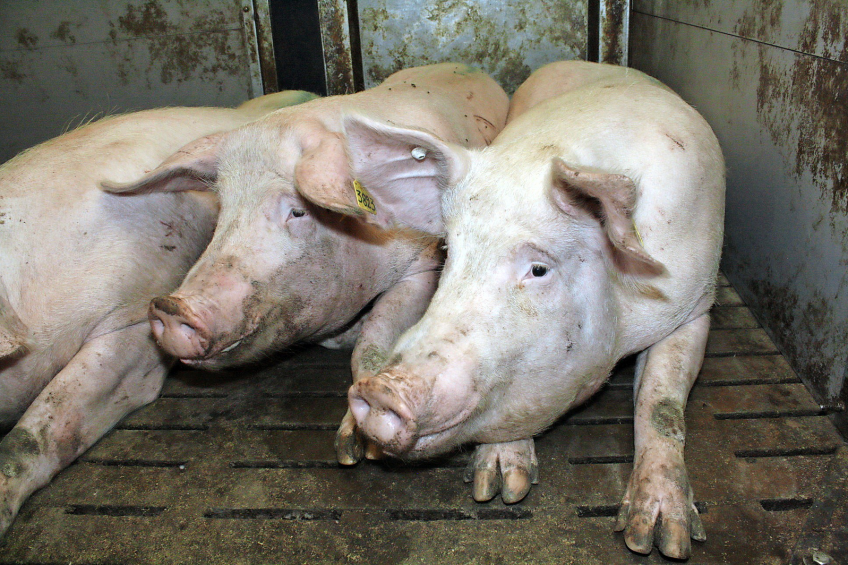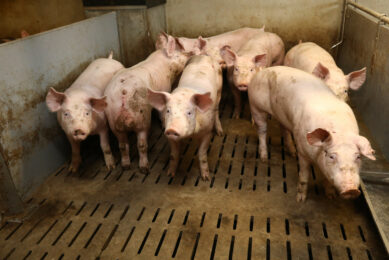Healthy sows lead to better piglets

It isn’t quite clear whether France has fully met all new EU guidelines with regards to group housing for gestating sows. Where the change was applied, however, reactions are positive. Sébastien Menguy, pig breeder near Plussulien, Brittany, France, explains.
By Vincent ter Beek
In the middle of his new group housing section, with several sows nibbling at his boots, Sébastien Menguy explains about his animals’ behaviour of late. Gesticulating with his hands he imitates a calmly treading sow on her way towards the exit, when the time for farrowing is near. It’s one of the effects that have made the most impression on him, he says, since the farm in 2011 switched to sow group housing. The sows appear more sedate, at ease, as in: He doesn’t have to push them.
As from the beginning of 2013, all pig breeding farms in the European Union have to comply with the latest laws: Gestation crates are no longer allowed during the majority of gestation. Instead, the sows should have the opportunity to stretch their legs. It’s up to producers to choose which system they choose. Since it is an EU directive, the measures apply to France as well.
It is no secret that many French pig producers, mostly in the region of Brittany, have been struggling with the new regulations. Profits have not been great in recent years and for many family-sized operations, necessary changes come at such a cost that especially older producers decided to opt for an (early) retirement.
Sébastien Menguy, however, is 34 years old. Despite having worked as a salesman, he decided to take over Earl Menguy farm from his father Jean-Claude, 60, and mother Marie-France, 58. They preferred to continue taking care of animals but no longer carry the responsibility for the mixed pig and cattle farm. The farrow-to-finish farm has 350 sow places and an additional 50 cows, and also 150 ha of arable land, which is used to cultivate a variety of crops, including corn, wheat, barley and rapeseed. All harvested crops are being sent to the cooperative Cooperl Arc Atlantique – which is also the farm’s compound feed provider.
Serious changes
Menguy set to work as from 2009 and applied some serious changes on the farm. He is in the process of upgrading the sow’s farrowing facilities, changed most pigs’ diets from liquid to dry feeding, added a phosphorus treatment during manure processing – and perhaps the most important operation, he made the breeding facility 2013-proof. He says, “I think at the moment France is over 90% compliant with the new European regulations. When I took over from my dad, I complied too.”
He was looking for a method which would allow for good management systems even when the sows would walk loose and finally chose to go for group housing with an Electronic Sow Feeding system using Nedap technology. The five stations, all placed in one large room, feed and sort the sows by reading the sow’s ear tags as soon as they visit the station.
Obtaining a loan for the adjustments was not a problem. Not only feed-wise is Menguy closely connected to Cooperl, France’s largest pig cooperative – he also sends his pigs there for slaughter. Since he decided to maintain the farm’s 350 sows, the facility needed expanding in order to accommodate the group housing system. The existing site was therefore expanded by about 600 m2 – the additional part measures 30 x 22 metres.
Menguy feels the ESF system has been a success. Apart from the sows being quieter when moved to the farrowing areas, he points to a reduction of claw problems in comparison to conventional housing. “I had expected it to be more, but no – it was the opposite. I now only have one or two coming back with problems.”
Animal welfare is having a positive effect on production, he noticed – they go hand in hand. “Of course it is good to see the sows having some freedom. When the sows can walk around and be active, they can keep themselves healthier. And healthy sows lead to better quality piglets.”
Asked if he should have moved to an ESF system earlier if he had known about it, his answer is positive. “But well, if you don’t know about the possibilities, you always assume that the system you have at that moment is the best.” The only problems he usually encounters in the very beginning, is when new entries appear in the dynamic group of about 250 animals. They usually fight a little bit to establish hierarchy, but it does not often take very long. The animals have plenty of space to go and lie down, and thus avoid any fights.
Most sows are sent into the group housing immediately after insemination. The only exception here are the young gilts, for which a training procedure has been set up. The gilts – bred on-farm using only Large White sows – are kept apart during the first three weeks of their first gestation in their own free access stall facility. During the fourth week, they enter the conventional ESF zone, but will get their own compartment with their own ESF station so they do not have to compete with the older sows. Furtively, they have had some training in advance as well. In the house where gilts are kept in their grower phase, one door of the ESF system has been playfully integrated in their home. This way, the young animals get acquainted to the concept of a feeding station door from a very young age. Menguy: “All they have to learn once they are in the group housing zone, is that this door leads them to feed. They learn very quickly.”
Finishing
The market pigs at Earl Menguy are crossbreeds (sows are Large White x Landrace, boar is Piétrain). On-farm, Menguy also has a grow-finishing section – the total capacity is 1,440 grower places and 3,100 finishing places.
The growers are located in the farm’s oldest part, which was built in 1980. They receive three types of feed during the grower phase. As is common in France, the grower facilities are cleaned inside out after each batch has moved on.
The slats are easy to open after which intense cleaning is possible. The finisher building is from 1995. The animals are kept in groups of twelve to fifteen, receive the oldest type of feed – they are fed ‘soup’ – liquid feeding. The mixture is prepared on-site by mixing dry feed with water prior to sending it to the pigs. It does make the finisher stables relatively dust-free. The pigs are sent to slaughter when they reach an age of approximately 115 kg liveweight.
Earl Menguy, France
Farm type: Farrow-to-finish farm
Pigs/sow/year: 25
Vaccinations: M. hyo; PCV2 (piglets); Parvovirus, E. coli, PRRS (sows)
Live-born pigs/litter: 14-15
Pigs weaned/litter: 11-12
Weaning: 28 days (7-8 kg)
Finisher places: 3,100
Finishing weight: 115 kg (liveweight)
Slaughterhouse: Lamballe (Cooperl)
Specifications: The farm also has 50 dairy cows and 150 ha for crop culture.











